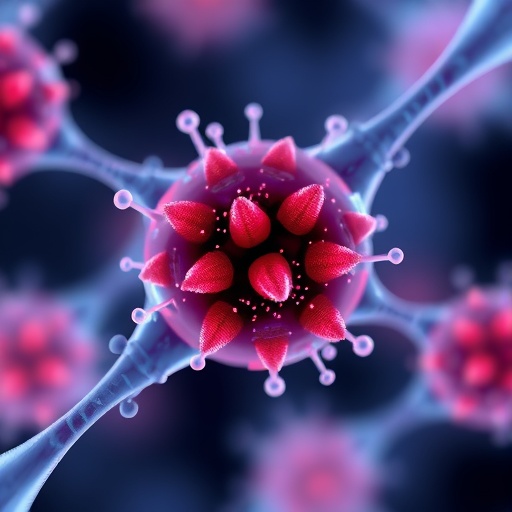In a groundbreaking development that could redefine cancer therapies, researchers have unveiled a new molecular engineering strategy poised to significantly enhance the effectiveness of photodynamic therapy (PDT). The innovative approach, termed a hindrance-plane-hindrance molecular engineering strategy, leverages self-assembled nanorods to overcome longstanding barriers in targeting and treating malignant tissues with light-activated mechanisms. This breakthrough, detailed in a recent publication in Nature Communications, introduces a highly sophisticated design paradigm that optimizes nanoscale architecture for improved therapeutic outcomes.
Photodynamic therapy has emerged as a promising alternative to traditional cancer treatments due to its precision and minimally invasive nature. This therapy uses light-sensitive compounds known as photosensitizers that, upon activation by specific wavelengths of light, generate reactive oxygen species (ROS) to selectively destroy cancer cells. Despite significant progress, the clinical efficacy of PDT has been limited by challenges in delivering photosensitizers effectively and ensuring their stability and activity within the tumor microenvironment. The novel approach presented by Tang, Q., Xue, B., Jia, H., and colleagues circumvents many of these obstacles by engineering nanostructures with enhanced self-assembly properties.
Central to the strategy is the concept of a “hindrance-plane-hindrance” molecular arrangement. This design introduces spatial constraints at the molecular level that control the orientation and packing of photosensitizer molecules within nanorods. By precisely modulating these hindrance effects, the researchers have achieved self-assembled nanorods that exhibit superior photostability, enhanced light absorption, and efficient ROS generation. Such control at the molecular scale ensures that the photosensitizers remain active longer and deliver more potent therapeutic effects upon illumination.
The self-assembly process itself relies on finely tuning intermolecular interactions to ensure the robust formation of elongated nanorod structures. Unlike conventional nanoparticle assemblies, which may aggregate unpredictably or disperse inefficiently, these nanorods maintain uniformity and alignment that maximize their photodynamic capabilities. The researchers utilized advanced synthetic chemistry techniques to introduce steric hindrance groups that act as spatial “braces,” stabilizing the nanorod configuration without compromising functional accessibility.
Comprehensive physicochemical characterization revealed that these nanorods possess exceptional optical properties tailored for PDT applications. Their absorption spectra are finely tuned to fall within the biological transparency window, allowing deeper tissue penetration of activating light. Additionally, the nanorods demonstrate high quantum yields of singlet oxygen generation, the primary cytotoxic agent in PDT, which translates directly to improved destruction of cancerous cells.
Crucially, in vitro and in vivo experiments validated the enhanced therapeutic efficacy of these self-assembled nanorods in cancer models. Cell culture studies showed significantly higher rates of tumor cell apoptosis following PDT treatment with the nanorods compared to traditional photosensitizer formulations. Animal studies further substantiated these findings by demonstrating marked tumor regression and minimal side effects, highlighting the translational potential of this technology.
Beyond the immediate clinical implications, the molecular design principles outlined in this study offer a versatile platform for engineering nanostructures with bespoke properties across various biomedical applications. The ability to harness steric hindrance to dictate nanoscale morphology and function may inspire new approaches in drug delivery systems, imaging agents, and multi-modal therapies that integrate PDT with chemotherapy or immunotherapy.
Moreover, the researchers addressed longstanding concerns regarding the biocompatibility and biodegradability of engineered nanomaterials. The nanorods are composed of materials designed to decompose into non-toxic metabolites post-treatment, thereby minimizing long-term accumulation in healthy tissues. This biocompatible profile was confirmed through extensive histological analysis and toxicity assays, suggesting that the nanorods are safe for repeated clinical use.
From a mechanistic standpoint, the study elucidates how the hindrance-plane-hindrance configuration influences intra- and intermolecular electronic coupling. This subtle electronic modulation underpins the nanorods’ efficient light harvesting and ROS production, offering new insights into the photophysics of self-assembled therapeutic nanomaterials. Such understanding could catalyze future innovations that exploit electronic structure engineering for enhanced biomedical function.
Importantly, this strategy also improves the formulation stability of photosensitizers in physiological conditions, preventing premature quenching or deactivation. The resultant nanorods retain their activity through prolonged circulation in the bloodstream and preferentially accumulate in tumor tissues via the enhanced permeability and retention (EPR) effect. This targeted delivery reduces systemic toxicity and improves therapeutic indices, a critical consideration for patient safety and treatment efficacy.
In the broader context of nanomedicine, the hindrance-plane-hindrance molecular engineering approach exemplifies the power of rational design in overcoming limitations posed by molecular crowding and aggregation. The study underscores the possibility of creating highly ordered nanostructures that marry form and function seamlessly, heralding a new era in nanoscale therapeutics where precision at the atomic level drives clinical innovation.
Future directions will involve scaling up the synthesis of these nanorods and conducting comprehensive clinical trials to establish their efficacy and safety in diverse cancer types. Additionally, integrating this molecular engineering framework with emerging photonic technologies could further refine light delivery methods, enabling more precise spatiotemporal control of PDT activity.
This pioneering work, therefore, represents a significant leap forward in the field of targeted cancer therapy, marrying cutting-edge nanotechnology with sophisticated molecular engineering to unlock new frontiers in treatment efficacy. The implications extend beyond PDT, offering a blueprint for designing next-generation nanomaterials that operate with unparalleled precision in complex biological environments.
As cancer diagnosis and treatment enter an increasingly interdisciplinary era, the hindrance-plane-hindrance molecular engineering strategy shines as a testament to how fundamental chemistry principles can directly translate into transformative clinical modalities. Researchers and clinicians alike will undoubtedly watch with keen interest as this promising technology progresses from the laboratory bench to the patient bedside, potentially rewriting the narrative of cancer care.
In summary, the development of self-assembled nanorods through the hindrance-plane-hindrance molecular engineering strategy represents a powerful advancement in photodynamic therapy. By leveraging controlled steric hindrance and molecular packing, the approach enhances photostability, singlet oxygen generation, and tumor targeting, addressing critical limitations that have previously hindered PDT efficacy. The study not only expands the therapeutic potential of PDT in oncology but also catalyzes future innovations in nanomaterial design with broad implications for biomedical science.
Subject of Research: Molecular engineering of self-assembled nanorods for enhanced photodynamic therapy
Article Title: A hindrance-plane-hindrance molecular engineering strategy towards self-assembled nanorods for enhanced photodynamic therapy
Article References: Tang, Q., Xue, B., Jia, H. et al. A hindrance-plane-hindrance molecular engineering strategy towards self-assembled nanorods for enhanced photodynamic therapy. Nat Commun (2025). https://doi.org/10.1038/s41467-025-66470-9
Image Credits: AI Generated
Tags: enhancing photosensitizer deliveryhindrance-plane-hindrance molecular strategyimproving therapeutic efficacy in oncologylight-activated cancer therapiesminimally invasive cancer treatmentsmolecular engineering in cancer therapynanorods in medical applicationsoptimized nanoscale architectureovercoming barriers in cancer treatmentphotodynamic therapy advancementsreactive oxygen species in PDTself-assembled nanostructures





